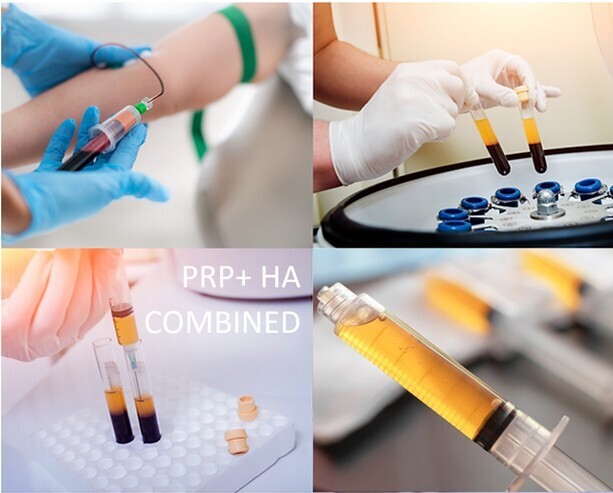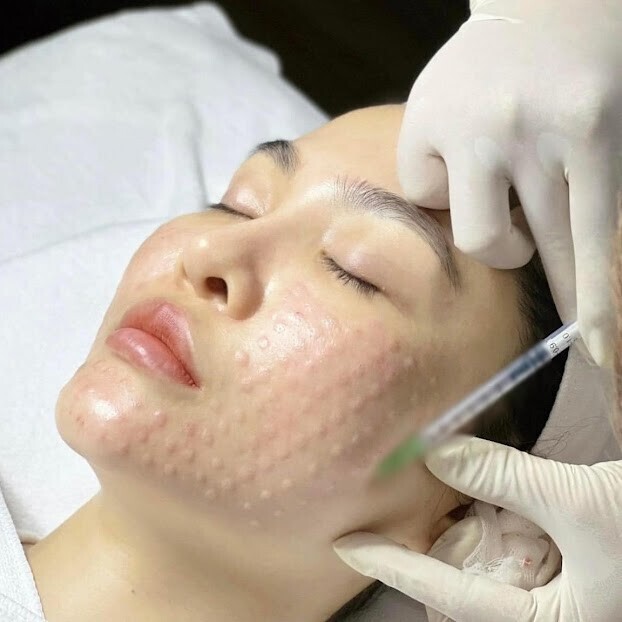- How it works
- What is involved with the PRP Hydration Therapy treatment?
- Pre-treatment instructions
- Contraindications
- Post-treatment instructions
- Where else can you use PRP Hydration Therapy?
- How does PRP Hydration Therapy help with resurfacing?
A PRP Hydration Therapy works with platelet-rich plasma (PRP) derived from your own blood and Hyaluronic Acid (HA) are combined. This mixture is then injected into the areas where the patients needs hydrating and antiaging benefits.
Benefits of PRP Hydration Therapy
- Overall improvement to skin texture & tone
- Smooths fine lines
- Improves hydration
- Natural looking results – no change in facial expressions
- Long-lasting results – regenerating your body’s own tissues
- Stimulates natural hyaluronic acid – an alternative to normal dermal fillers
- Reduced wrinkles – filler effect directly tackles facial lines
- More luminous skin – treatment leads to brighter skin tone
The most common treatment areas include the face, neck, decolletage and hands, but the PRP Hydration Therapy can also be used on the body.
PRP Hydration Therapy works by injecting PRP + HA. This stimulates the body’s natural wound-healing response, kick-starting the biological processes that create new collagen and elastin. While the filler provides the instant skin plumping effect, the PRP stimulates regeneration of healthier, more taut skin.
Aging and environmental damage break down these essential structural proteins, and the rate of replacement slows over time. Procedures like PRP Hydration therapy can slow and reverse this process, helping skin look more youthful.
Before the procedure, the skin is anesthetized with ointment to provide the client with maximum comfort. In preparation for the PRP Hydration Therapy, a blood sample will be collected and placed into a centrifuge to isolate the platelets. Plasma Rich Platelets (PRP) gets extracted from the blood sample and combined with a Hyaluronic Acid or HA.
After the treatment area is disinfected, the powerful cocktail is administered via mesotherapy, multiple micro injections just below the skin with a PRP and hyaluronic acid (HA) cocktail.
While injecting, the pore-plumping PRP cocktail will be massaged in, and allowed to absorb.
After the procedure, the skin is may appear swollen and possibly flushed. In most cases, everything disappears in the next few days.
The skin condition will improve over time as a result of regenerative processes.
- Avoid the use of non-steroidal anti-inflammatory drugs (NSAIDs like aspirin, Motrin, Advil, ibuprofen, or any other non-Tylenol, non-acetaminophen product) for two weeks prior to treatment to minimize the potential for bruising. Discuss any current medications that you are taking with your doctor prior to stopping or pausing usage.
- Hydrate: for seven days prior, moisturize your skin in the morning & evening.
- Stop all topical acids (like glycolic, alpha, or beta hydroxyl acids), retinol, Retin-A, or other like products 7 days prior to treatment.
- Avoid tanning beds or prolonged exposure to the sun 14 days prior to treatment. Always use a zinc oxide sunscreen with SPF 30+.
- Remove all substances from the intended treatment area, including topical numbing cream, tanning products, ointments, lotions, perfumes, bath/shower oils, deodorants, etc.
- Pregnancy or nursing
- Under 18 years of age
- Possibility of Infections in the areas targeted for PRP therapy
- Current or history of cancer, especially skin cancer, or pre-malignant moles
- Anticoagulant prescription medications or antiplatelet therapy
- Impaired immune system due to immunosuppressive diseases such as AIDS and HIV, or use of immunosuppressive medications
- Severe concurrent conditions such as cardiac disorders, epilepsy, uncontrolled hypertension, and liver or kidney diseases
- A history of diseases stimulated, such as recurrent Herpes Simplex in the treatment area or active facial or oral herpes infection
- Any active condition in the treatment area, such as sores, psoriasis, eczema and rash as well as excessively/freshly tanned skin
- History of skin disorders such as keloid scarring, abnormal wound healing, as well as very dry and fragile skin
- Any medical condition that might impair skin healing
- Any surgical, invasive, ablative procedure in the treatment area in the last 3 months or before complete healing
- Cosmetic treatments including neurotoxins, filler, threads, Sculptra will need to be evaluated for possible contraindications or risks.
- Use of Isotretinoin (Accutane®) within 6 months prior to treatment due to the increased risk of scaring
- Currently taking antibiotics
- Any surgical procedure in the treatment area within the last three months or before complete healing.
- Treating over tattoo or permanent makeup.
- Excessively tanned skin from sun, tanning beds or tanning creams and sprays within the last two weeks.
- Uncontrolled diabetes
- Blood-clotting problems
- Allergy to any components of injectable hyaluronic acid
- Allergy to PRP separation ingredients including sodium citrate
Immediately after treatment PRP or the EGF serum may be used on treatment area to help boost results.
After 24 Hours the post care skincare routine may be initiated:
- Wash skin with the Gentle Cream Cleanser with cool water. Avoid using towels or abrasive scrubbing cleansing cloths. Pat dry once rinsed with water.
- Tone skin with the Calming Flower Mist.
- Apply post care safe serums after toning options include: Phyto Calm Aloe Drops, EGF Drops, or Antistress CBD.
- Additional post care safe serums include the HA Revive Hydrator Dops or Daily Hydration Drops.
- Moisturize with the Phyto Calm Hydrator or Vita E Moisturizing Cream.
- Apply SPF of 30 or higher 15 minutes before sun exposure and reapply as needed.
Additional advisories:
- Expected downtime can vary depending on treatment settings and may range between 1-7 days. The expected healing sequence and expected treatment side effects include redness, swelling, bruising, light discomfort, and pinpoint bleeding.
- Ice should not be used after PRP Hydration therapy injections. Inflammation is an important part of the healing process. Ice reduces inflammation and swelling and therefore may compromise the healing process. Ice also prompts the blood vessels to get smaller thereby restricting blood flow. Blood flow is critical to healing. One of the precautions after PRP injections is to avoid ice.
- Rest and healing are important after PRP injections. It is important that the injected PRP be given the opportunity to heal the affected area. In order of this to happen the PRP must be given the opportunity to set in place. Platelets release important growth factors and proteins that promote tissue regeneration and healing. It takes up to seven days for the growth factors to be released from the platelets. Exercise may displace and move the PRP from injected site thereby compromising healing and outcome.
- Alcohol can negatively affect platelet function. Specifically, it can decrease its platelet activation and aggregation and response to other proteins and enzymes. Alcohol can also affect stem cell numbers and function which may compromise healing.
- During the healing process keeping the items in contact with treatment areas in clean. This may include: clean pillow cases, linens, wiping down cell phones or any accessories coming in contact with treated skin.
- Avoid washcloths and harsh cleansers until all transient healing processes have resolved naturally.
- Sleep with a slight elevation of your head to help with any swelling.
- Avoid sleeping with pets for 24 hours.
- Avoid excessive sun exposure in the treatment area and use sunscreen (SPF 30+) for one month following the procedure.
- Contact the office if you have any concerns about how your skin is responding to treatment or is healing.
- If you are healing well, you may resume using mineral makeup 24 hours later. Do not resume the use of topical acids, retinol, Retin-A, etc. for 7 days.
The most common treatment areas include the face, neck, decolletage and scalp but the PRP Hydration Therapy can also be used on the breast, buttocks, abdomen, knees, thighs, and almost any other body area.
PRP Hydration Therapy causes a natural response to produce new collagen-rich tissue and increase skin hydration. Generation of new, collagen-rich tissue tightens skin, reduces scars, wrinkles, stretch marks and fine lines in the skin. This thus improves the overall texture and appearance of your skin.


